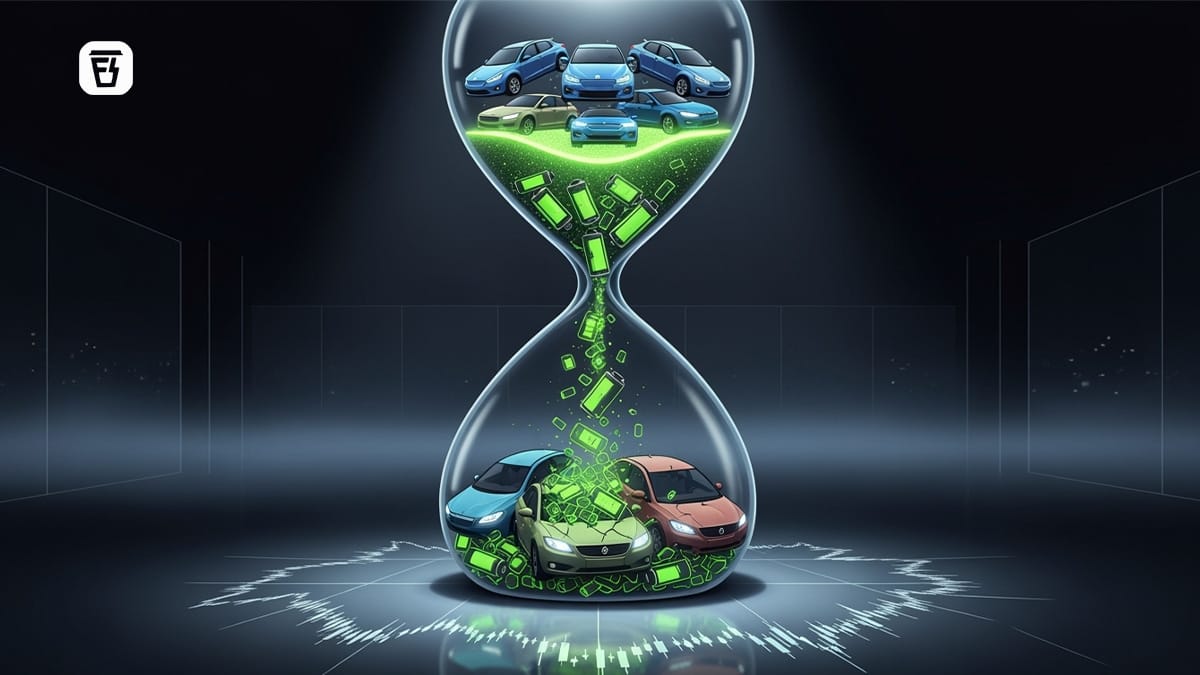What happens when EVs flood the used market?

In today’s Finshots, we look past the shiny new EV launches to ask a less glamorous but decisive question: what happens to electric vehicles when they become second-hand?
But before we begin, if you’re someone who loves to keep tabs on what’s happening in the world of business and finance, then hit subscribe if you haven’t already. If you’re already a subscriber or you’re reading this on the app, you can just go ahead and read the story.
The Story
In July this year, electric vehicles (EV) crossed a small but significant milestone in India. For the first time ever, they accounted for over 5% of all vehicle registrations. That meant nearly 1.8 lakh new EVs took to the roads in just one month.
While two-wheelers did most of the heavy lifting, electric car sales also picked up pace. Tata’s EVs keep finding buyers, Mahindra is doubling down on its BE (Born Electric) lineup, and Tesla also entered the Indian market last month.
Add to this excitement, VinFast has already set up a $500 million plant in Tamil Nadu to manufacture and export EVs, and is talking of another $1.5 billion investment in the country.
All of this got me thinking: when an industry scales this fast, something predictable happens a couple of years later.
On the face of it, this feels like the kind of momentum that governments and environmentalists have been waiting for. More EVs on the road should mean less dependence on fossil fuels and cleaner air in our cities.
But a new vehicle sold today eventually ends up in the used market, recycling plant, or the dump. As today’s EVs start aging, they will have to find buyers in a resale market accustomed to dealing with EVs, rather than petrol and diesel cars.
You see, India’s resale bazaar is huge. It’s already worth over $20 billion and continues to grow. And this wouldn’t be that much of an issue, just 15–20 years ago, when the world was full of vehicles with internal combustion engines.
This is because its resale value was calculated in a fairly simple manner. Say, predictable factors like the brand’s reputation, the reliability of the vehicle, the cost and availability of spare parts, and how well the car has been maintained.
But EVs bring a very different equation into play. They flip the script because one component dominates value. The battery alone can account for 50 to 60% of the vehicle’s worth. If the rest of the car is pristine but the battery is written off, the resale value collapses. Replacing it is expensive, and in some cases, may cost so much that it is not even financially worthwhile.
However, the trouble is that battery value is tied not just to age, but to how much capacity it has lost over time. Just like your phone’s battery, EV batteries also degrade with usage.
In ideal conditions, EV batteries degrade by about 1.8% a year. And in a tropical climate like India’s, that degradation can be much faster. In fact, a study found that batteries lost three times more capacity per year in hot climates when they were also charged frequently using rapid chargers. That works out to a loss of about 5.4% each year.
At the other extreme, careful charging and milder weather can keep declines near 1%. India is not mild for most of the year. Put that together, and you can already see the valuation problem:
How do you price two identical three-year-old EVs if one was fast-charged outdoors in Chennai summers and the other charged overnight in a shaded car park in Jammu?
If that sounds like a niche inconvenience, look at the dominoes it can tip. A weak second-hand price hurts first-hand sales because buyers care about exit value, especially for big-ticket purchases.
Banks set loan-to-value ratios using expected residuals. If they cannot estimate what a three-year-old EV will fetch, they either lend less or charge more. Insurers apply the same logic to determine the car's declared value, which is then reflected in premiums and claim settlements.
Then, there is also the physical issue of end-of-life care. If resale tanks and the battery is not economical, owners will be tempted to run the pack into the ground and dispose of the car, or worse, dispose of the battery. And lithium-ion packs contain materials that need careful handling. If the promise of EVs is cleaner air and lower pollution, none of that matters if batteries end up in scrap yards.
But this is where the opportunity lies.
If we can accurately measure battery health and price it effectively, we can build an entire second-hand battery economy. If we can accurately measure that a battery pack has lost 20% of its driving range, someone who travels long distances frequently may avoid that purchase. But this could be perfect for someone who just travels from home to work most days. It’s a predictable commute, and even if you have to run errands, you’re unlikely to encounter issues due to range.
Another opportunity lies in battery replacement and refurbishment. That means modular packs, clear part numbers, and a policy stance that does not punish owners for swapping a tired pack for a certified refurbished one.
In fact, Hero is already manufacturing scooters with removable batteries, and Ather wants to launch a Battery-as-a-Service model to reduce the upfront costs.
While this can be more complicated for 4-wheelers, manufacturers could start by offering a price guarantee for replacement batteries, which would starve the grey market of unsafe tinkering. If warranties are transferable to second owners and explicitly cover a minimum State of Health over time, resale strengthens further.
There is also a policy angle here. If the government wants more people to choose electric vehicles, it cannot just focus on selling new ones. It has to make sure the resale market works too. That could mean setting clear standards for how EVs depreciate, encouraging battery replacement programs so that a used EV can get a new lease of life, and building out infrastructure for recycling batteries safely.
Apart from this, with ethanol-blended petrol becoming the mandate for ICE vehicles, older cars that are not rated for ethanol could inherently lose value. This gives EVs a chance to stand out, provided their resale prices can hold up.
The bottom line is simple. India has crossed the early adopter hump, so the second-hand market will decide whether EVs go mainstream.
If the goal is cleaner cities and lower oil imports, set the rules that let an EV hold its value, keep its battery out of the dump, and give the next owner a fair deal.
For now, the real test will come when the first wave of EVs sold over the past few years starts entering the used market. That is when we will find out whether India’s electric dream holds its charge beyond the first owner.
Until then…
Don’t forget to share this with your friends, family or even strangers on WhatsApp, LinkedIn and X.
🔊Introducing Pitch Perfect 2025!

If you've been following us for a while, you know our story didn't begin in a corporate boardroom. It started in a college dorm room with 3 broke students who chose to skip placements and chase something bigger.
That something was Finshots.
Today, Finshots reaches over 500,000 readers, and through Ditto, we've empowered 800,000+ Indians to make smarter insurance decisions.
Now, we're looking for the next game-changing idea to back.
Introducing Pitch Perfect 2025 – a flagship startup pitch challenge powered by Zerodha.
So, if you've got a BIG idea that could help Indians get better with money, pitch it to us!
What's at stake:
✅₹10,00,000 in prizes
✅Potential funding from Zerodha Rainmatter
✅All-expenses-paid trip to Bangalore to pitch directly to Nithin Kamath and industry veterans
Ready? 👉Apply Now!
